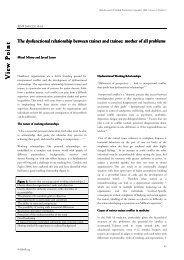R esearch A rticle - British Journal of Medical Practitioners
R esearch A rticle - British Journal of Medical Practitioners
R esearch A rticle - British Journal of Medical Practitioners
Create successful ePaper yourself
Turn your PDF publications into a flip-book with our unique Google optimized e-Paper software.
<strong>British</strong> <strong>Journal</strong> <strong>of</strong> <strong>Medical</strong> <strong>Practitioners</strong>, March 2013, Volume 6, Number 1<br />
BJMP 2013;6(1):a602<br />
Case Report<br />
Eslicarbazepine use in Multiple Sclerosis with refractory Trigeminal Neuralgaia<br />
Tarek A-Z K Gaber, Myint Myint Kyu and Wah Wah Oo<br />
Abstract<br />
When associated with Multiple Sclerosis (MS), Trigeminal Neuralgia (TN) is <strong>of</strong>ten bilateral and more refractory to treatment. Carbamazepine is the first<br />
line <strong>of</strong> treatment for TN, however, common side effects <strong>of</strong> carbamazepine such as hyponatremia occasionally limit its use.<br />
We report the case <strong>of</strong> a 62 year old female patient with a well controlled MS associated TN using carbamazepine. This drug needed to be discontinued<br />
because <strong>of</strong> recurrent symptomatic hyponatremia. Several agents including topiramate, gabapentine and amitriptyline were tried but none had any beneficial<br />
effect on TN. A small dose <strong>of</strong> eslicarbazepine (400 mg daily) provided excellent control <strong>of</strong> the TN pain on one hand and did not affect the plasma sodium<br />
levels on the other hand.<br />
Eslicarbazepine main advantage is providing the same effects <strong>of</strong> carbamazepine or oxcarbazepine but with an incidence <strong>of</strong> hyponatremia <strong>of</strong> less than 1%. It<br />
is much safer to use when the risk <strong>of</strong> hyponatremia is increased. To our knowledge, this is the first case that reports the use <strong>of</strong> eslicarbazepine in one <strong>of</strong> the<br />
several indications <strong>of</strong> carbamazepine such as pain and mental health problems. Eslicarbazepine use in epilepsy was reported extensively.<br />
We feel that a therapeutic trial <strong>of</strong> eslicarbazepine is justified when either carbamazepine or oxcarbazepine have to be discontinued because <strong>of</strong> hyponatremia<br />
despite their efficacy.<br />
KEYWORDS: Eslicarbazepine, Trigeminal Neuralgia, Multiple Sclerosis, hyponatremia<br />
Trigeminal Neuralgia (TN) is relatively rare in Multiple<br />
Sclerosis (MS) affecting approximately 2% <strong>of</strong> patients 1 . The<br />
severity <strong>of</strong> the pain is indistinguishable whether TN is an<br />
isolated impairment or is associated with MS. However, when<br />
associated with MS, TN is <strong>of</strong>ten bilateral, affecting younger<br />
patients and is more refractory to medical treatment 2 .<br />
Several pharmacological agents are reported to be effective in<br />
TN associated with MS. Topiramate 3,4 , gabapentin 5 and<br />
lamotrigine 6 were all reported to benefit patients with TN<br />
associated with MS in small uncontrolled trials. Several other<br />
drugs such as phenytoin, misoprostol and amitriptyline are<br />
routinely tried in patients with TN despite the lack <strong>of</strong><br />
convincing evidence <strong>of</strong> their efficacy 7 .<br />
In 2008, Both the American Academy <strong>of</strong> Neurology and the<br />
European Federation <strong>of</strong> Neurological Societies launched joint<br />
Task Force general guidelines for the management <strong>of</strong> TN. After<br />
systematic review <strong>of</strong> the literature the Task Force came to a<br />
series <strong>of</strong> evidence-based recommendations 8 . Carbamazepine<br />
and oxcarbazepine had the strongest evidence <strong>of</strong> efficacy and<br />
were recommended as the first line treatment. An earlier<br />
Cochrane systematic review reached the same conclusion. 9 .<br />
Case report<br />
A 62 year old female patient had been suffering from MS for<br />
about 20 years. The MS presented with trigeminal neuralgia<br />
from the outset and this was then followed by pyramidal lower<br />
limbs’ weakness and sphincteric dysfunction. The patient<br />
started to use a wheelchair 10 years ago but she became totally<br />
wheelchair dependent about 6 years later.<br />
Trigeminal neuralgia remained active throughout the 20 years.<br />
Carbamazepine (300 mg daily) provided the patient with a<br />
satisfactory control <strong>of</strong> TN. Despite having occasional break<br />
through TN pain; the patient declined having higher doses <strong>of</strong><br />
carbamazepine as excessive sedation was an unacceptable side<br />
effect.<br />
Recently; the patient was admitted to hospital in two separate<br />
occasions complaining <strong>of</strong> increasing malaise and confusion.<br />
Plasma sodium levels were found to be low in both occasions<br />
(first presentation 118 mmol/l and second admission 114<br />
mmol/l). Clinical evaluation confirmed Syndrome <strong>of</strong> Anti<br />
Diuretic Hormone Secretion (SIADH) as the cause <strong>of</strong> the<br />
hyponatremia and in the absence <strong>of</strong> any other explanation for<br />
the SIADH; carbamazepine was thought to be the main reason<br />
and was duly discontinued.<br />
Unfortunately, TN attacks came back with vengeance. During<br />
the following 6 months, therapeutic trials using gabapentine,<br />
topiramate and amitriptyline failed to show any beneficial effect<br />
on either the severity or the frequency <strong>of</strong> the TN attacks. All<br />
three drugs were duly discontinued.<br />
The patient was started on eslicrbazepine 400 mg on a single<br />
daily dose. This dose lead to almost complete eradication <strong>of</strong> the<br />
TN attacks. The control <strong>of</strong> TN and the plasma sodium levels<br />
remained stable a year following the initiation <strong>of</strong> the therapy.<br />
Comments<br />
Hyponatremia, defined as a sodium level < 135 mmol/l is a<br />
common side effect <strong>of</strong> carbamazepine and oxcarbazepine<br />
BJMP.org<br />
32







